#Nihonshoki
Explore tagged Tumblr posts
Text

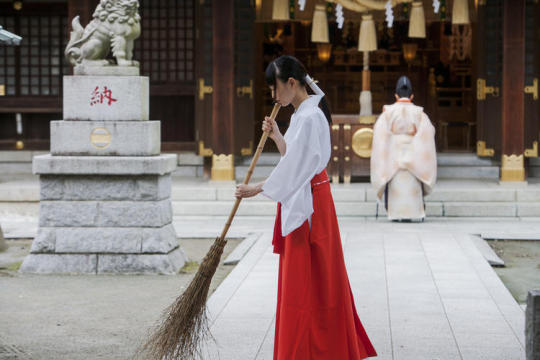


Sean bienvenidos mis queridos fanáticosarqueológicos a una nueva entrega de prehistoria Japónesa en esta ocasión nos trasladamos a la pregunta ¿Cuándo se originó el sintoísmo?. - Aunque parezca raro es una religión que se conformo durante el periódo Jōmon (17.500-300), para ser exactos a finales de dicho período y continua hasta nuestros días los dioses del sintoísmo, se les llama Kamis ( dios) ya que para los japoneses todo tenía un dios las montañas, ríos. - El sintoísmo tiene influencias chinas, coreanas de hay que tenga similitudes con el taoísmo, ¿Qué dos libros recogen la categoría de los Kamis? Son el Kojiki(713d.c) y el Nihonshoki(720d.c). - Espero que os guste y nos vemos en una próxima públicacion un cordial saludo. 🇯🇵 私の愛する考古学ファンを日本の先史時代の新作に歓迎します。今回は、神道がいつ始まったのかという質問に移ります。 - 奇妙に思えるかもしれませんが、縄文時代(17500-300)に形成された宗教であり、正確にはその時代の終わりに、今日まで神道の神であり、カミス(神)と呼ばれています。 日本人にとって、山や川にはすべて神がいました。 - 神道は中国、韓国の影響を受けており、道教との類似点があります。 カミスのカテゴリーに分類される2冊の本は何ですか? こうじき(713d.c)と日本書紀(720d.c)です。 - よろしくお願いします。次の出版物で心からのご挨拶を申し上げます。 🇬🇧 Welcome my dear archaeological fans to a new installment of Japanese prehistory, this time we move to the question, when did Shintoism originate? - Although it may seem strange, it is a religion that was formed during the Jōmon period (17500-300), to be exact at the end of that period and continues to this day the gods of Shintoism, they are called Kamis (god) since for the Japanese everything the mountains and rivers had a god. - Shintoism has Chinese, Korean influences, and there are similarities with Taoism. What two books are classified under the category of the Kamis? They are the Kojiki (713d.c) and the Nihonshoki (720d.c). - I hope you like it and see you in a next publication a cordial greeting.
#kamis#kami#japanese gods#history#japan#jōmon#jōmon period#prehistory#japanese prehistory#taoism#china#korea#religious history#kojiki#Nihonshoki#カミス#カミ#日本の神々#歴史#日本#城門#ピリオドジョモン#先史時代#先史時代日本人#道教#中国#韓国#ヒストリアレリギオーザ#コジキ#日本書紀
92 notes
·
View notes
Text
The Real Ryomen Sukuna, Everything you have to know about that man!
The king of curses, the malevolent kitchen itself, but did he really exist? Where, when, and who was the strongest curse in history? Did Gege approach this case like the others, leaving historical hints in Sukuna as well?
According to some records, Ryomen Sukuna is a figure from ancient Japanese legend who appeared in the Hida Province during the reign of Emperor Nintoku. This is the depiction of Sukuna that Jujutsu Kaisen also uses, but it's not the only one. Emperor Nintoku himself is an interesting figure in Japanese history, so if you're interested in Japanese history, definitely look him up. He is one of those buried in a kofun, a mysterious ancient structure similar to the pyramids of Egypt, but that’s enough about Nintoku.
Sukuna had two faces, four arms, and four legs, with the faces and limbs located on both the front and back of his body. His two faces and four arms make him comparable to mythological beings like Janus from Roman mythology, the god of transitions and beginnings. Like Janus, Sukuna, with his dual faces, may have symbolized opposites and duality, representing both evil and good, destructive and protective forces. His height varies depending on the source, but he was significantly taller than the average people of that time (in some sources, he reached 50 meters, while in others, he was only slightly taller than the people of his era).

He was fast, super strong, and fought with weapons. Although little is known about him, as the Nihonshoki is such an ancient source with few equals outside of the Kojiki, similar information is scarce. Speaking of his weapons, we can again find some connections with Gege’s work. His main weapon was the bow, which—though in an extreme form—also appears in the second season and the manga under the name Divine Flame (竈 カミノ, Kamino).

According to the 'Nihonshoki,' Sukuna was merely a feudal lord, not a curse or demon. As I mentioned, there’s no evidence supporting his existence, yet he was featured in major ancient writings. From this, I infer that whether or not he existed, he was important enough to be mentioned, meaning that people of the time knew his name. Even as a man, he wasn’t without credit—he defied the imperial court and caused suffering to the people, so in 377, a general was sent to defeat him. However, in Hida and Mino provinces, he was revered as a hero and worshipped as a deity in several temples. His hidden deity status in the Minashi-jinja shrine suggests that his figure might have been connected to Shinto gods in some way. The local sacred mountain, Kuraiyama, was worshipped as the dwelling place of gods, and some theories suggest that Sukuna could have been the god of that mountain. Some even believe that Sukuna introduced Buddhism to the Hida province.
Anyone reading articles here knows that Buddhism always comes up—it’s one of the core themes of Jujutsu Kaisen when it comes to fight choreography, but it’s also an integral part of the characters. You can find references in their names, or you couldn’t deny that Geto Suguru himself is a reincarnation of Buddha—or at least his head is.
Other theories suggest that Sukuna might have been a symbol of twins or brothers, or perhaps the ruler of a dynasty in Hida that rivaled the Yamato dynasty. The stories of Oousu no Mikoto and Ousu no Mikoto, or Yamato Takeru and his brother, as well as Emperor Chuai’s sons, Kagosaka no Miko and Oshikuma no Mikoto, are all examples of brother pairs whose fates intertwined with Hida and Mino provinces. (Let's not even go into this… Japanese history surpasses any soap opera.) It’s said that he helped local communities and supported the region. He was worshipped in many local temples and shrines, and in several places, he was honored as a 'kaiki,' or temple founder. Here, I’ll insert a picture of Hida and Mino prefectures, for those interested in where this person lived:

So no trace? Archaeologists think otherwise, as several items bearing Sukuna's name still exist in modern-day Japan! A special, two-faced haniwa (clay figure) was discovered near Wakayama city, dating back to the Kofun period (early 6th century). This haniwa resembles Sukuna and suggests that the cult or iconography of two-faced figures was present in ancient Japan. Furthermore, the already mentioned Sukuna Kabocha, a pumpkin found in the Hida region, is linked to Sukuna’s name, although the exact connection remains unclear. Even though it’s not directly proven to be tied to Sukuna’s legend, this plant still serves as an intriguing reference to the local cultural heritage.

To be honest, I was skeptical, I didn't think so much could be discovered, but once again I wasn't disappointed by the master. Sukuna is more than the king of curses, and Gege Akutami is more than just a mangaka, he is a true historian.
~Getam 2024.10.02
#jjk#jujutsu#kaisen#jujutsu kaisen#gege akutami#kaisend#phonology#research#anime#manga#heian#kanji#megumi#joumon#history#kyoto#buddhism#mikkyo#shounen#geto suguru#nihonshoki#kojiki#ryomen sukuna#sukuna
35 notes
·
View notes
Text
Nihon Shoki - Wikipedia
0 notes
Photo

Époque de Nara
L'Époque de Nara (Nara Jidai) de l'ancien Japon (710-794), appelée ainsi parce que pendant la majeure partie de cette période, la capitale était située à Nara, alors connue sous le nom de Heijokyo, fut une courte période de transition avant l'importante période de Heian. Malgré sa brièveté, cette période produisit tout de même les œuvres littéraires japonaises les plus célèbres jamais écrites et certains des temples les plus importants encore utilisés aujourd'hui, notamment à Todaiji, le plus grand bâtiment en bois du monde à l'époque, qui abrite toujours la plus grande statue en bronze de Bouddha jamais réalisée.
Lire la suite...
1 note
·
View note
Text
i fucking hate weeb culture u all i had to jump over 10 pages of google to find decent informative sources about kitsunes and shinto religion for yuna lore because all the main pages where either anime or the 348976458379564897 hypersexualized deviantart edgelords
#anyways#the nihonshoki carried my ass#such a good book god bless the ez access on google dlfkg#also searching by “huli jing” helped a lot too to avoid the anime jumpscares
33 notes
·
View notes
Text
HEY!! I think the gods REALLY have to do with Ai and Hikaru!!! (theory)
I've been looking into Ame-no-Uzume, Amaterasu and Sarutahiko's lores as of recently and the gods Ame-no-uzume and Sarutahiko have really similar dynamic with Ai and Hikaru right...
Well, remember that time in onk when the characters all went to pray at the Aratate shrine in Miyazaki for good luck? That shrine worships Ame-no-uzume, and it's mentioned in CH 74 and 79. When it's mentioned the first time, Aqua's reaction towards the name Amenouzumeno-mikoto is rather weird... he says he knows about her "really well"... why is he like that towards the name? That bugged me when I first read it and it still does too. Since he's aware of the gods actually being in existence, he could have encountered things that have to do with her, wouldn't it?
Anyway, I looked up the name of the shrine and guess what??
That region is associated with all three gods, Amaterasu, Sarutakhiko and Ame-no-Uzume. It's where the legends related to them took place, and the shrine HAS to do with not just Amenouzume but her Husband, they are worshipped together in that particular shrine. The place is also where the twins lived and passed and where the hospital Gorou worked in's located. This could be why the names "Amaterasu" and "Ame-no-uzume"'s been brought up, they really have to do with the story in some way.
Here's the description of the shrine found from the link below:
"A shrine that is often visited by celebrities, Aratate shrine is said to bring good fortune in show business and marriage. This shrine is dedicated to Sarutahikono-mikoto and his wife Amenouzumeno-mikoto who gave directions to Ninigino-mikoto the grandson of the sun goddess upon his descension from the heavens."
This must have some significance to the story.
Yeah, I bet Hikaru's name came from that god who's the husband of Amenouzume, and I looked more into this god, he's always worshipped with his wife. There's another shrine that's dedicated to him in the Ise region:
"Sarutahiko-JinjaShrine is also located within the precincts of Sarutahiko Shrine, facing the main shrine. Amenouzume-no-mikoto, enshrined at Sarume-JinjaShrine, is known as a god that brings good fortune in the entertainment industry and marriage, and is visited by many celebrities."
The common aspect these shrines share with one another is that they bless the people in the entertainment industry. More like Sarutakahiko blesses the land in general, with his wife bringing good fortune to the people related to the arts since she's the god of the arts. Anyhow, they seem to be really close, huh, it's kind of cute to see people always allowing them to be together and dedicating a place for her in his shrines.
And what Sarutahiko does or is supposed to do is to "guide things in the right direction".
I brought the original text for this in case the auto-translation gets off:
猿田彦神社にまつられている猿田彦大神(さるたひこのおおかみ)は、古事記や日本書紀にも登場する神様です。
天照大神(あまてらすおおみかみ)の孫である瓊瓊杵尊(ににぎのみこと)を地上の世界まで道案内したと伝えられ、物事のはじまりに道しるべとなって、何事も良い方向へと導いてくださる「みちひらき」の神様として知られています。
It translates to this:
Sarutahiko is the deity enshrined at Sarutahiko Shrine, and is mentioned in the Kojiki (Records of Ancient Matters) and Nihonshoki (Chronicles of Japan).
He is said to have guided Ninigi no Mikoto, a grandson of Amaterasu no Mikami, to the earthly world, and is known as the god of “Michi-Hiraki” who guides us in the right direction at the beginning of things.
So he's supposed to be the god that maintains order.
Ring a bell? I've mentioned this in the other theories I posted yesterday, but if there is really a god that deals with "absurdity and unreasonableness", this is the guy they would try to get at. He's the one that'd get in their way of things.
I think Ai really could be "Amenouzume", she's the one who's brought Ruby to her new life, the way that goddess brought Amaterasu out from the cave she retreated into. And if she's amenouzume, or at least is an incarnation/blessed by her, she has to be paired with her husband who's always worshipped together with her. Ai has a boyfriend she had children with, and his name just awfully screams he has to do with a god in some way, especially the one that deals with light. Sarutahiko EMITS light. His other name (I'm so sorry for saying this for like 100th time in a row) is "god of the bright lights". It seems like they have a loving relationship from the lores I read about them.
If you look at it from a neutral standpoint, Hikaru's life's been a series of suffering just one after another. And I keep looking at him, his personality actually still doesn't seem that twisted after all he's been through. He's too meek. I was really keen on how this guy'd turn out to be like because he was really suspicious right? but every time he makes an appearance, it does seem like he has something on his mind but it doesn't seem like he is even capable of showing any type of aggression to the extent it feels almost surreal. Why doesn't he show any anger towards others when he's clearly been continuously mistreated? It's sad because maybe people could be like that, but I still feel the level is very extreme. He should have resented people. He could have turned bitter. Distant. Selfish. He should have screamed and lashed out but he only smiles and accepts and stays quiet. I don't sense any negativity or hostility towards other people in the way he acts so far and I studied psychology. I have a feeling Ai's really chosen a super sweet guy to love. This guy is awfully kind in nature. Am I going to be wrong about this? But I want to get it out there, he seems like a genuinely good person. Too kind for his own good. If that is what's so, then the reason WHY Ai would want to help him makes a lot of sense to me. It's strange... At this point it'd make more sense for me if he REALLY turned out to be some god.
I think something's really after him to disrupt balance, wouldn't THAT be a good reason to force the gods to step in? The plot of onk must be involving/related to these three gods at a minimum. There's been SOMETHING that's been thrown out there, it's been brushed off or unthought of because it's too absurd and fantasy-like, but I think it can be important!!
There is also another thing I noted: yesterday I found Ame-no-uzume belongs in the "Amatsukamis", 天津神(あまつかみ). The gods from the skies-
Her husband Sarutahiko isn't. He belongs in the "Kunitsukamis" 国津神(くにつかみ) and belongs on the land.
If Ai is compared to a "star", He's been compared to a "jewel". That analogy makes sense, actually, since jewels belong on the land even while they shine. So he's actually NOT a star in essence like Ai. If Ai returns to being a star, he cannot reach her from where he is because they originate from different places. Hence, the lyrics of Mephisto starts making a lot of sense. No matter how hard he tries, she's out of his grasp.
So I'm guessing he could have been tricked or lured into the hopes of being allowed to meet Ai again/that she could be brought back to life by ANOTHER "STAR". Probably a god that belongs in the Amatsukami category.
It all clicks really well for me but I wonder if the writers really thought of all this.. Of course, whatever they'd thought up would be way more detailed and in-depth than I, but I mean in terms of the direction of the story. I could be way off about this, but it actually works!! This idea that even if they were to be gods, they STILL wouldn't be able to meet if they returned back to where they came-that's a really clever set-up, if their lore really has to do with this. I'd be impressed if that's really what's been going on.
Anyhow I'm pretty sure Hikaru's been doing something to bring Ai back... I really want that to be discussed if that's really what's been happening. In that case, he gave up on what he'd been desiring for over a decade, on the spot, to respect her wishes. That's selfless of him... but just how many lines did he cross? How much wrong did he commit?? I need this guy to be expanded upon but will it? I guess if that happens he could take all the spotlight so, but I still want to know what's going about around him. There's so much weird stuff that's been happening around this guy and it doesn't seem like a coincidence.
That's it for now~ I'll draw something based on this idea! :) The lore between Amenouzume and her husband was very cute. When I look them up, the tour guides and stuff always seem to portray them as a happy couple and I like that. I like the fact she approached him first too~.. of course, I should do more research if I wanted to know about them better and I could be wrong, but.. I love reading about myths and folklores of different countries and I love seeing couples that get along well. They seem to have a lot of descendants too~
Those gods seem to love people a lot and do a lot of favors for them, there are purification rituals, protective spells, a lot of good fortune in general. They even bless marriages and you can actually get wed in the sarutahiko shrine, it says (well, the gods were married themselves so makes sense)
If Ai and Hikaru's really them, I see why they love people because that's how they've always been. Regardless if they are, or if they aren't.. I hope they will be happy somehow.
7 notes
·
View notes
Text
big time ramble up ahead be prepared (mostly about Izanami and the actual Mythology in Shinto religion and Persona 4's character designs regarding my poll I posted)
(this is like my third time writing this btw so please I hope yall enjoy it)
so I did a poll regarding ship kids yesterday and I got a good amount of votes that I liked!! Nothing crazy and it was meant to be a critique view in my eyes, I like criticism when I ask for it and I wanted to see how others felt :]

and in the comments @/thiscityneedslessfog mentioned Izanami is technically already a parent and it made me wanna do a mini deep dive on the Shinto Mythology and seeing which gods/goddesses I wanna maybe make into p4 ocs!! Just smth to tie into Izanami + I think it can warrant fun doodles. Anyways let's get into it

SO.
We all already know at least one of Izanami's kids, Kagutsuchi (photo below), who burned her at birth and was the reason she was sent to Yomi in the first place and turned into goddess of death (yall know the legend yall are smart)

HOWEVER before Kagutsuchi, specifically a little after Izanami and Izanagi's first ritual that they accidentally messed up, Izanami had Hiruko and Awashima, both who weren't considered deities due to the deformities they faced due to the messed up ritual. Both were put on boats and sent away by the currents where Izanami and Izanagi restarted the ritual and got it right this time (leading to a fuck ton of islands to be created and aforementioned Kagutsuchi)
now Xo note, while Hiruko actually did wound up becoming a god, specifically one of the seven gods of fortune, god of fishermen and luck, Ebisu, (statue below), I could not find any information on Awashima, not even what their gender was supposed to be. My only source (linked below) on Awashima for like. all their stuff. says that they're a female/woman orientated god, such as female disorders, pregnancy, etc, but in my readings Awashima did exist, just not alot of them is written?? no idea

So technically speaking, not counting the islands, Hiruko, Awashima, and Kagutsuchi are Izanami's kids canon wise in p4
In the story, after Izanagi saw Izanami's decaying corpse, he cleansed himself and created three new gods
Amaterasu, goddess of the sun, birthed from Izanagi's left eye

Tsukuyomi, God of the moon, birthed from Izanagi's right eye

and Susanoo, god of the storms, birthed from Izanagi's nose

Technically speaking, these three are Izanagi's kids ONLY. Izanami had no part in this...
However.
In a seperate telling from the Nihonshoki version of Izanami and Izanagi's tale, Izanami and Izanagai together created Amaterasu, Tsukuyomi, and Susanoo, just after Hiruko, Awashima, and Kagutsuchi and after izanamis turn to goddess of death
so. depending on which one p4 is based on (which I do not know), Izanami rather has just three kids or six kids (not counting islands once again)
however considering I'm the one wanting to go through with making designs for these guys in p4's style, it is genuinely just up to me, and if I wanna design 6 characters
WHICH I WOULDNT MIND AT ALL!! I LOVE CHARACTER DESIGN TRUST!!
BUT.
I'm not used to persona 4s way of character design. All the characters are simple but recognizable. It doesn't use crazy out there hair or outfits for you to recognize who is who and that's super neat!!God,
Even if you look at the lineup of sprites of characters (below) they're all like people you can see in daily life (maybe except teddy and fox) ofc more exaggerated for some since that's the style in p4 for characters who are NPCs, but either way they're people you could see in daily life. Even Izanami herself when she reveals herself is pretty normal. just the robe and loose hair fits perfectly to that simplicity

Even the investigation team (below) def has a unique set of designs even if they're really simple. Their silhouettes are almost close but not close enough. You can still easily identify them by the simplicity of different hair styles and different outfits which IS COOL!!!

But my art style is def more y2k/2000s art style. Think My Life As A Teenage Robot, Invader Zim, Samurai Jack, etc, (which are a few of my inspirations for my style alongside a few other artists I see on insta). So I'd instantly want to exaggerate and what not. And I feel I CANT DO THAT THIS TIME RAAHHH!!!
point is. I'd love to design these gods/goddesses as ocs for silly scenarios for Izanami and even my Adanami slop. I just feel I gotta keep in mind p4 itself and not just go crazy about designs (which I tend to do for any fan ocs I've noticed-)
idk SOMEONE YELL AT ME on if I'm crazy or not. I really just wanted to ramble on the kiddos of Izanami and Izanagi and kinda discuss p4's designs and how I am gonna STRUGGLE but I'll still try 🥺
anyways thank you for reading. OrcaOttoXo out

#izanami persona#persona 4#p4#mythology#just a long ass ramble#also character design ramble#and me tweaking#yea#persona 4 oc#oc discussion???#oc discussion#sure yea
4 notes
·
View notes
Text

Shinto is a religion of Japanese origin whose aim is to establish harmony between man and nature. Shinto is considered to be a way of life for the Japanese people. Unlike other religious organisations, it doesn't have a founder or a holy book, but is based on ancient texts called Shinten: The Kojiki: The oldest scripture, a trilogy that tells the oldest stories about Japanese mythology; the second is the Nihonshoki or Nihongi which are Japanese chronicles, and the last Kogo-shui which talks about the family of the Imbe.
2 notes
·
View notes
Text
Round 1 Poll 30
Futsunushi The Nihonshoki sword deity who pacified Ashihara-no-Nakatsukuni. His name comes from "futsu," the fashion in which things are cut, and "nushi," his nature as a god.
Kin-ki One of the four oni controlled by Fujiwara no Chikata, its body is so hard that no weapons can penetrate it.


4 notes
·
View notes
Note
for the character ask prompt! what about Keiki?
General opinion/How much I care about them: She's a very solid character and surely part of the reason why WBaWC feels like one of the most-liked recent games! When the full version came out a lot of my friends and mutuals who were past touhou fans but had lost their interest came back thanks to that game specifically, so in my brain she's linked to that moment of shared happiness. I like how she's very much a classic god in terms of personality while being easier to reach than the others thanks to her role to the human spirits. I feel like she'd be easy to talk with, as long as you don't forget she's still a god of course, and I really like characters who act as a bridge of sort between others. She's also definitely unhinged under all that and it's fun to imagine situations where the politeness just goes out of the window.
A ship I love: (puts on my clown makeup again) My favorite Keiki ship is with Okina..... It's pretty high up there in my fav touhou pairings overall too lol. They're both loners and I tend to really enjoy romantic pairings where two people get to feel a bit less lonely together. I just think they'd get along really well! and I like their shared connection to art in general. The two of them crafting something special together is a nice image... It's also funny to imagine Keiki playing along Okina's boasting about her status and her powers as a secret god etc when Keiki is a god herself. She's Keiki's poor little meow meow!!! Oh and I also quite like Keiki/Mayumi too. I wish the fanon interpretation of them as parent/child would die down already... it's a bit sad that they didn't take off on the english speaking side as well as they did in the jp community even though literally everyone asks for more knight/princess wlw ships. It's Right There
A non-romantic relationship that I love: Gotta admit I haven't thought about her sphere of relationships much beyond the ones that also work as romances, but I love the implication that she's Eika's younger sibling if you follow the mythos. Keiki would probably be quite protective of Eika despite being the little sister... And with the recent addition of Hisami I'm really excited to see more fanworks with the characters based on the Nihonshoki/Kojiki (this better not monkeypaw on me). They need to have tea and chat about the old times!!!
The NOTP: It's Yachie/Keiki, sorry guys but I'm a yachisaki believer.....
My biggest headcanon about them: I'm pretty sure I've already mentioned that one in the past but the beast-shaped aura in her portrait looks like a familiar to me! Maybe some kind of fire spirit to help her crafting :)
An idea for a fanwork I would like to make/see about them: I'd like to read a good fic/comic where she interacts with the other beast leaders seriously... I'm so sad she didn't get proper dialogue with Saki or Yuuma despite them being as much of a threat as Yachie. As for something I would like to make myself... A visual retelling of some of Koda Rohan's works (especially Furyubutsu) but with Keiki as the protag is an idea I've had for 2-3 years but if I ever get to it, it'll probably just be little doodles :-)
Something that makes me think of them: Koda Rohan's work again lol (delusional)
17 notes
·
View notes
Text
Pottery I made for Tenjin Sama
Can't remember if I shared this or not. But my host family took me and my roommate out to a local pottery studio to make our own rice bowls.



It was a lot of fun, and we got to pick how to decorate them and a glaze color. I of course added the classic plum motifs.


We had to wait a bit before they were finished, but the end result was quite beautiful!



I always tell people that one of the ways to connect to kamisama is to create in whatever way you can.
Sugawara no Michizane's family has historical ties to pottery makers, so this was a perfect way to connect to him, and it resulted in a lovely devotional piece!
The clan ties are to the Haji clan, which apparently in the Nihonshoki: "The Chronicles of Japan records a legend that Nominosukune, the ancestor of the Haji clan, came up with the idea of placing haniwa (clay figurines) on mausoleums as an alternative to martyrdom during the reign of Emperor Suinin." They also had roles in creating tombs, and performed burial rites for the imperial family. [x]
0 notes
Text
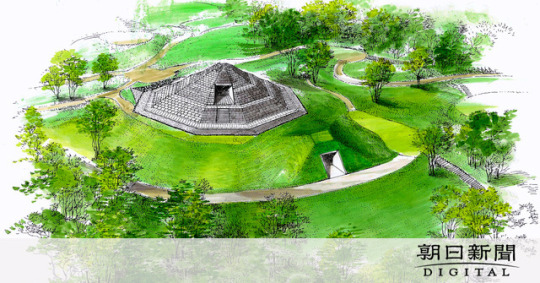

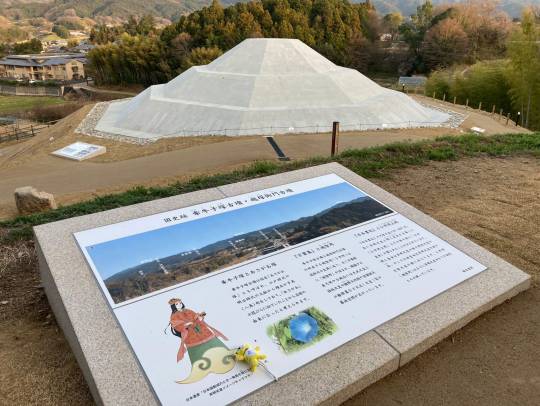
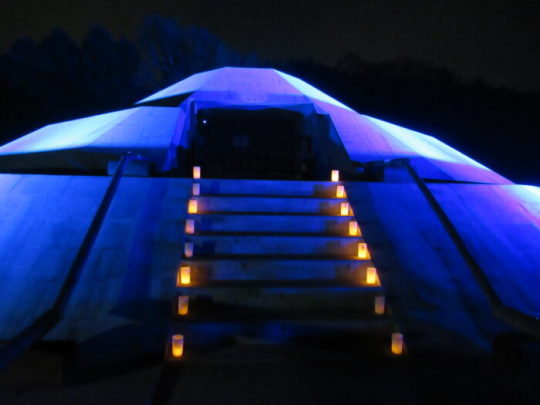
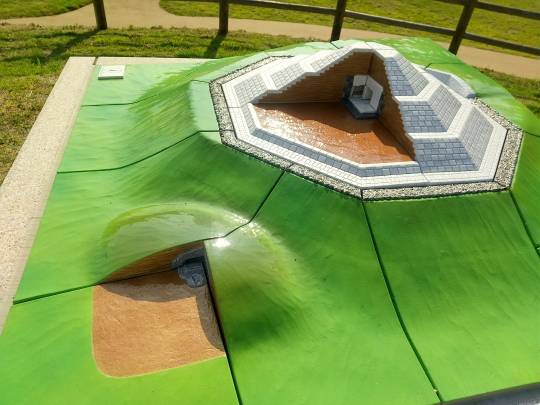


Sean bienvenidos japonistasarqueológicos a una nueva entrega sintética de arqueología japonesa, en la cual hablaremos de el Túmulo funerario Kengushizuka, una vez dicho esto pónganse cómodos que empezamos. - El Túmulo funerario Kengushizuka, se localiza en Koe, pueblo de Asuka, distrito de Takaichi la prefectura de Nara, se construyó en el periodo Asuka lo que sería a finales del siglo VII. En el Nihon Shoki son las Crónicas de Japón en el que se afirma que en el 667d.c en el reinado de la emperatriz Saimei. - Espero que os haya gustado os deseo una buena semana y nos vemos en próximas publicaciones del país del sol naciente. - 日本の考古学者を迎えての新しい総合回です。今回は「牽牛子塚古墳」についてお話しします。どうぞごゆっくりとお過ごしください。 - 奈良県高市郡明日香村小江にある牽牛子塚古墳は、飛鳥時代、7世紀後半に築かれた古墳です。 日本書紀』には、西暦667年、斉明天皇の時代と記されている。 - 楽しんでいただけたなら幸いです。良い一週間をお過ごしいただき、日出ずる国から今後の出版物でお会いできることを祈ります。 - Welcome Japanese archaeologists to a new synthetic installment of Japanese archaeology, in which we will talk about the Kengushizuka burial mound, so make yourselves comfortable and let's get started. - The Kengushizuka burial mound, located in Koe, Asuka village, Takaichi district, Nara prefecture, was built in the Asuka period in the late 7th century. In the Nihon Shoki are the Chronicles of Japan in which it is stated that in 667 AD in the reign of Empress Saimei. - I hope you enjoyed it, I wish you a good week and see you in future publications from the land of the rising sun.
#japan#asukaperiod#historyjapan#unesco#kofun#emperor#prefecture#Nara#naraprefecture#KoeTown#NihonShoki#EmpressSaimei#-#日本#歴史#古墳#滅んだ飛鳥#奈良県#日本史#ユネスコ#天皇陛下#斉明天皇#甲越市#日本書紀#考古学
40 notes
·
View notes
Note
Would you mind expanding upon Shudō (hope I spelled that right 😭🙏)
I've tried looking it up to learn more about it but I always get conflicting answers
I do my best translating the information I have about Shudō since I tried to find information in English, but I haven't seen much, or at best it's poorly translated or decontextualized (Sort of happened the same in Spanish)
Advise!!! The infomation I have comes in part from what has been described to me in some discussions in my history classes, something that happened several years ago and I don't have the proper context of why that talk was given in the first place, and information that I have collected and summarized from different historical blogs and websites that probably have points of view and prejudices that do not allow a clear definition of the concepts to be described. Any error you see in the information please give a advise or correct me.
From the medieval period (1185 - 1603) until the end of the 19th century, Shudō (abbreviated as Wakashudo) was a common practice and seen as normal among the samurai society of Japan. Shudo can be translated as “the way of the young man”, “the road of the young man” or “the path of awakening”. It consisted of homosexual practices between a young man and his master, as a form of sexual awakening, but above all to instill values such as honesty and virtue.
In the couple, Nenja is used to describe the older man and Wakashū is for the youngest man.
The primary objective of shudo was to prevent men from having their first sexual contact with women since they could acquire “feminine habits” or “become feminized”. The warrior had to be anything but docile or sensitive, attributes considered exclusive to women in those times.
The term shudō appeared for the first time in the 17th century; it's preceded by the Japanese homosexual tradition among bonzes and acolytes, known as chigo. The legendary and supposed founder of this type of relationship in Japan was Kūkai, also known as Kōbō Daishi, the founder of the Shingon monastery, who is said to have brought with him the knowledge of male love along with the knowledge of Shingon. Mount Koya, where Kōbō Daishi's monastery stands today, was synonymous with male love until the end of the pre-modern period.
Despite the attribution of male love to Kūkai, the actual roots of homosexuality in Japan can be traced back to some of the earliest Japanese texts such as the Kojiki and the Nihonshoki. The teachings of shudō entered the literary tradition and can be found in works such as the Hagakure and other samurai manuals. Shudō, in its pedagogical, martial, and aristocratic aspects, is similar to some ancient Greek traditions.
The practice was held in high regard and was encouraged, especially within the samurai class. Was considered beneficial to youth, teaching them virtue, honesty, and appreciation of beauty. It's value is contrasted with the love of women, which is blamed for the ''feminization of men.''
1 note
·
View note
Photo

Katana-kaji — Master Japanese Swordsmiths
Katana-kaji , the master craftsman who makes the wonderful Japanese katana or tohken swords. It is possible to trace the origin of tohken to the Kojiki (Archives of the Ancient Masters) and Nihonshoki (The oldest chronicles of Japan) texts. These were considered sacred treasures rather than a weapon, offered to deities at shrines, and placed in the tombs of royals.
The Japanese katana evolved into its current form during the second half of the Heian period (11th century) with the growth of the warrior or samurai class. Even then, the naga-yari (Japanese spear) and yumi-ya (bow and arrows) were the most common weapons on the battlefield, while swords were considered more of a protective amulet, an omamori . Today, katanas still have a similar use, ceremonial gifts at temples and shrines, and collectible treasures for fans of Japanese luxury crafts. A Katana-kaji must train for years to receive a certificate from the Japan Agency for Cultural Affairs. There are only about 300 katana-kaji masters in all of Japan.
A Katana-kaji begins the process of making a katana by creating the metal for the blade, or Jigane . Steel pieces called tama-hagane are made from powdered iron. These break into smaller pieces to be heated and form a larger piece. Continuously and repeatedly heated and struck, stretched and bent, as the steel begins to take the shape of the sword. This 900-year-old technique, called tanren , continues virtually unchanged, creating jiigane of great strength and extraordinary texture.
Continue Reading >>>
0 notes
Text

Well a month late. But glad that my girl, Amanozako aka Ama-no-Sagume is getting more recognition in recent days. The "heavenly priestess" turned og demon queen mother of demons is finally in the Onmyoji game. And I love that she's even carrying an arrow that refers to part of her story aswell that her "evolved form" design has even more references like the origin of the word Tengu/Tiangu (Heavenly Dog).


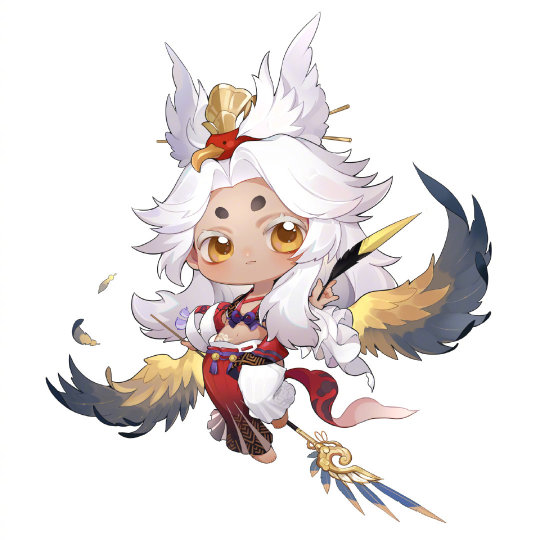
Before the fall
About Ama-no-Sagume 天探女
(source JPN wiki. Translated by DeepL)
In the Kojiki (Records of Ancient Matters), she is called Amasagume, and in the Nihonshoki (Chronicles of Japan), she is called Amatanagume. In the Hirama Shrine, the name "Amagusume-no-mikoto" is added to the name.
In the account of the pacification of the Plain of Reeds(aka Japan) in the Kojiki, Amaterasu talked with Takami-no-Misuhi and dispatched Amenohohohi-no-Kami, who did not fulfill his role, and then dispatched Amenowakahiko. When Amenwakahiko did not return to life for eight years, Shikinushi sent a pheasant named Nakīme to Amaterasu to advise him to ascertain Amenwakahiko's true intentions. The pheasant perched on a maple tree at the gate of Amenwakahiko's house and said, "You were dispatched to the Plains of Reeds, where you were ordered to bring the raging gods to submission. Amateru heard this, and he told her that he had been sent to the Land of Reed Plains and ordered to bring back the raging gods. Hearing this, Amesagusume told Amenwakahiko, "The cry of this bird is ominous. Amewakahiko then shot the pheasant with a bow and arrow, but the arrow pierced Nakime's chest and reached Amaterasu and Takagi (another name for Takamimisusuhi). Takagi picked up the arrow and said, "If you shoot an arrow at an evil god, it will not hit Amenowakahiko, but if Amenowakahiko has an evil heart, it will hit him." He threw the arrow back and it pierced Amenwakahiko's chest (this is called "kaeshiya," or "return arrow").
Although she plays an inauspicious role in the Kojiki, she is thought to have originally been a deified version of a miko, a priestess who received oracles and judged good and bad omens, and the existence of a miko who twisted oracles in an age when politics and rituals were one and the same was considered to be a rebellion against the gods and a disaster. It is also believed that perhaps for this reason, Amagusume was given a unique position different from other deities, and that in the Chronicles, the deities are addressed as "life" or "god," while Amagusume is called by a title [2]. In the "Settsu-no-Kuni-fudoki," Takatsu, it is written, "When Ame-no-Tsukihiko descended from the heavens, she belonged to Ame-no-Tsukihiko and descended to the gods, Amenotansume. The "Chronicles of Japan" says, "There is a national deity at times. In the Nihon shoki (Chronicles of Japan), however, there is a reference to a "national deity" as well. There is also a theory that she is the original image of the Amanojaku in folklore.
In the classics, Takatsu is sometimes said to be the place where Ama-no-Tanjo, riding on the Ama-no-Iwa boat, anchored. For example, the "Settsu-no-kuni-fudoki" (Anecdotes of Settsu Province), quoted in the Edo period's "Shoku-ka-rin Ryozai-shu," states, "Namba Takatsu was the place where the god Ama-no-Tanjo, who descended from the heaven when Ama-no-Chikohiko descended, arrived here on a rock-bottom boat(Iwafune aka the sacred stone boat of heaven which Sagume apparently owns and rows). The name "Takatsu" is derived from the place where the boat stayed. The Manyoshu also states, "Hisakata no ten no tanjo no ishibune no tomari shi Takatsu wa asase ni naruke (Hisakata no ten no tanjo no ishibune no tomari shi Takatsu wa asase 尓家留香裳) (scroll 3, no. 292).
Amanozako (天逆毎)
Alternatively: アマノザコ
Korean: 아마노자코 (Amanojako)
Traditional Chinese: 天逆每 (Tiān nì měi)
"Heaven Opposing Everything"

Amanozako like a Kijo (Female Oni, Ogress) or even amanojaku ⤴️
A rebellious yokai goddess that originated when her father the kami Susanoo let his own ferocious spirit and rage build up inside him (his aramitama) until he vomited her out. She is said to have a beastly face, a crooked long nose, pointed ears, sharp fangs and tusks so strong they can break even the strongest blades.
Amanozako is known to go against conformity and does the opposite of what is expected in society and social norms. She is said to be picky, and will go into an atrocious rage if she does not get what she wants, or if things do not go according to her way. When in this state, she can hurl even the most powerful gods distances of over one thousand villages in a single throw. Her wrath can't be easily stopped.
Stories of Amanozako were being told long before history began being recorded. It is said that she is the ancestor deity of all yokai who share her personality and disobedience. Some of these yokai include most notably the tengu, as well as amanojaku.
While she's said to be ancestor of many yokai her only child that has been named, thus far is Amanosaku. Which, due to her obstinate behavior, she brought into being all on her own. He is Amanozako's spawn, and is said to be just as terrible and disobedient as she is. Apparently, Amanosaku drove all 8 million gods in heaven mad, and because of this, Amanosaku was made the ruler of every malevolent or troublesome kami.
In terms of her godly abilities, other than what has been mentioned, the legends and stories say that Amanozako is a trickster, of sorts. She can peer into people's hearts and likes to possess the hearts of humans and manipulate their emotions and personalities. She's been also said to be able to fly for thousands of miles. It's also assumed she posseses all the powers of a demon goddess of her stature, and powers like her descendants including transformation (変化, へんげ, "Henge").
Amanozako holds titles like Hime (princess), tengu kami, metengu and possibly even of Queen due to what she is among yokai. As Susanoo's daughter she has many relatives including her aunt the sun goddess Amaterasu, her uncle the moon god Tsukuyomi, her brother Yashimajinumi (八島士奴美神 – Mighty Master Ruling Eightfold Isles) who was the original ancestor of many earthly kami and later humans as well like his aunt Amaterasu. Another notable relative mention is Izanami, her grandmother who later on went to rule Yomi and like her granddaughter, she was also one of the progenitors of Yōkai, birthing demon gods like Raijin and Fujin, thus making them also uncles to Amanozako.
While normally looking similar to a tengu, she's also been depicted like an ogress in various media.
Amanozako as seen in Touhou media ⤵️


Amanozako as seen in Shin Megami tensei
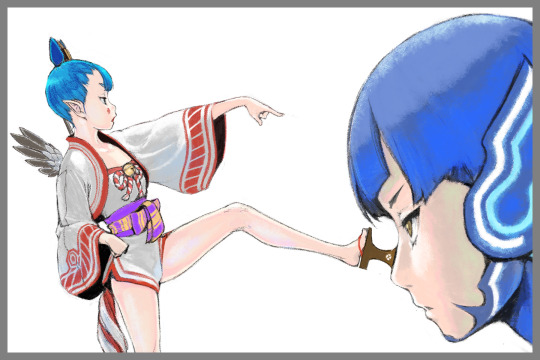
Original depiction of Amanozako
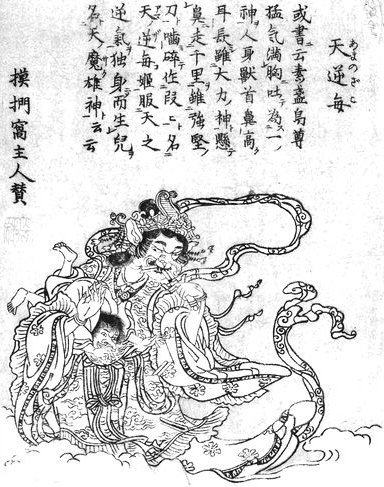
Amanozako as a regular tengu, like a karasu tengu and a guhin Tengu (dog tengu).
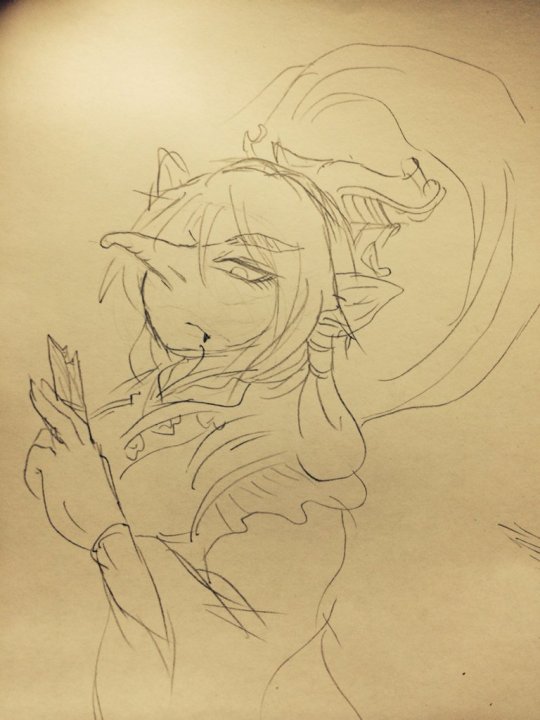

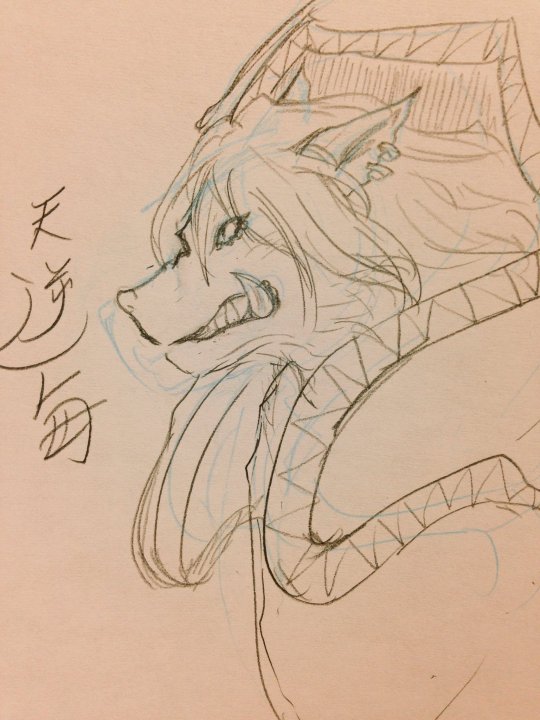

It's been fun studying yokai for my story.
#it's fun diving into these yokai myths#Amanozako#Ama-no-Sagume#tengu#amanojaku#yōkai#ayakashi#mononoke#miko#mamono#yaoguai#tiangu#maō#my current favorite goddess#hannya#kijo#female oni#karasu tengu#guhin tengu#youkai#obake#kemono#demon queen#japanese mythology#japanese folklore#kami#monster girl#horror japan#bakemono
44 notes
·
View notes
Photo

“Empress Jingu conquering the three korean kingdoms”, (1885), Adachi Ginko (active 1874-1875)
Print from the series: “A short illustrated history of great japan”.
#empress jingu#female warrior#female ruler#jingu kogo#kojiki#nihonshoki#women in history#japanese myths#asia#art#history#japanese art#japanese history#ukiyoe#woodblock print#japanese prints#korea#japanese culture#japanese artist#woman warrior#empress#female armor
342 notes
·
View notes